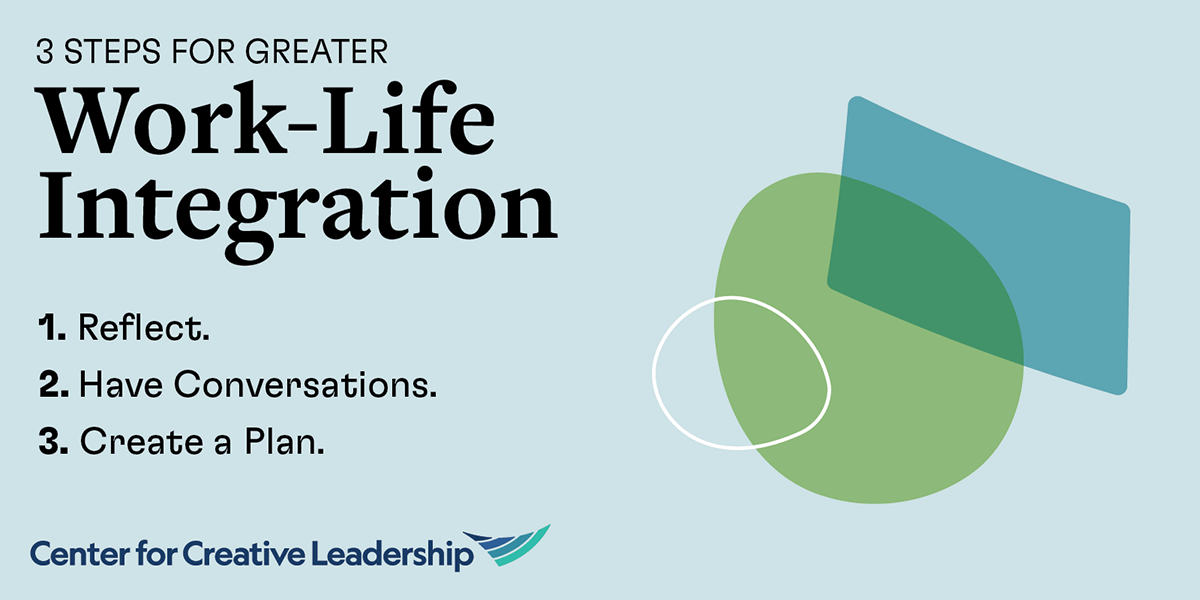“Balance” Is a Faulty Metaphor
Does it seem like there just aren’t enough hours in the day? Are you constantly being pulled in several directions, juggling priorities and demands? Most people would probably say they feel overwhelmed and out of sorts, which suggests they feel out of balance.
The often-mentioned concept of the competing priorities of work and life is “work-life balance.” Yet the balance metaphor — meaning an equal amount of our waking time split between life and work — just isn’t very constructive or realistic.
The idea that work and life can be “balanced” presents a false (and unhelpful) dichotomy. Using the word “balance” sets us up to think of “work” and “life” as an either / or, instead of a both / and. It creates a sense of a problem to be solved, instead of acknowledging a polarity to be managed.
Our research team recommends shifting to the idea of work-life integration rather than work-life balance.
Aligning Behavior With Personal Values to Drive Work-Life Integration
Work-life integration isn’t about achieving the “right” equation of time and effort, equally distributed among your commitments. It’s more a matter of choices and tradeoffs than of time, so think instead of aligning your behavior with your values. Parenting and leadership, for example, needn’t feel mutually exclusive.
The choice to prioritize work-life integration means you might work on weekends. Other times, you might work on personal stuff during the “workday.” The goal of work-life integration is to transition easily between activities that bring you joy and fulfillment, regardless of when they happen, where they’re located, or whether you’re getting paid.
People have more energy to give when they’re doing things they think have a real impact on something that’s important to them (whether it’s volunteering, work, or other activities). That’s true even when they’re working long hours.
So, think about the things both at work and at home that you can do that are important to you, and that allow you to live a happy life. Being able to do what you want to do isn’t just about hours; it’s about whether you have the energy and drive to do them.
Work-life integration is about feeling energized by what you’re doing in all parts of your life, allowing you to channel energy into taking care of whatever is important to you — both at work and outside of work. This is the idea behind practicing holistic leadership.
How Boundary Control Connects to Work-Life Integration
Our research suggests that work-life boundaries are more important than work-life balance. Where balance suggests an unrealistic image of doing it all — and in just the right amounts — boundaries open more options both for individuals and for organizations.
People vary, however, in how much flexibility they have to create boundaries within their work lives.
Our researchers have found that some people have higher or lower levels of boundary control, and that it has much to do with the circumstances or type of work they’re in.
- High Boundary Control: People with high work and life boundary control decide when to focus on work, when to focus on family, or when to blend the 2. For example, they may decide to work late to finish a large project. Or they might attend a school event on a weekday morning and only work a half-day. Individuals with high boundary control feel they have the authority and ability to make these decisions and to manage any resulting trade-offs.
- Mid-level Boundary Control: These people sometimes decide when to focus on work or on family, or when to blend the 2, but there are times when they feel they have no choice. For example, they can sometimes focus their attention and time on family matters during work hours, but there are times they’d like to, but can’t. They may want to separate or integrate more than they’re actually able to.
- Low Boundary Control: People with low boundary control don’t get to decide when they focus on work, when they focus on family, or when they blend the 2. In most cases, these limitations are established by the type of job they have, their personal circumstances, or both.
The more control a person has over where, how, and when they work and how they manage other responsibilities, the easier it is for them to fit the different pieces of life together and achieve work-life integration. Greater control also leads to a feeling of more autonomy and security.
But boundary control is only one of 3 factors that our researchers believe affect the integration of work and personal life. To fully understand your work-life situation, you must analyze your behaviors (what you’re currently doing), your identity (where you prefer to invest your time and energy), and your perceived control (your ability to decide when, where, and how to take care of work and family responsibilities).
3 Steps for Greater Work-Life Integration
How Leaders Can Begin a New Approach
Here’s a 3-step process we recommend for setting aside the unhelpful balance metaphor and creating work-life integration for yourself.
1. Reflect.
As much as you are able, try to live with intention both at work and at home to increase your energy levels and feelings of authenticity and effectiveness.
To ensure your behaviors align with your values, take time to reflect and clarify what matters most to you. Then consider whether you’re spending time in a way that’s consistent with your values.
- For one week, record what you do for any period of time of one hour or more. While you’re at it, write down why you did what you did. Do your actions reflect or contradict your values and goals?
- Or, take an inventory of the things you like to do best, including your skills and passions, the working conditions that you enjoy most, and what makes you happy. Then, reflect on what you can do to increase your involvement in similar activities.
You may also need to reflect on what you’re doing now as a choice you’re making instead of a situation you’re the victim of. Remind yourself why you’ve made the choice you have or why the current situation is what it is. For the moment, you may be focused on surviving a temporary challenge or setback. But if current demands don’t hold in the future, or if those reasons are no longer primary for you, consider what new choices you can make now or in a few months, so that you’re aiming for work-life integration, not making the 2 feel mutually exclusive.
Remember, your needs and expectations will continue to change, so keep coming back to reflect and set achievable goals for yourself that align with your values and current priorities.
2. Have Conversations.
Everyone needs support to achieve goals, especially those as complicated as work and family goals. After taking time to reflect, talk with friends and family about what you might do differently in the future as you prioritize work-life integration. Some might help you figure out how to best manage your time and energy or agree to take tasks off your to-do list. Others can provide encouragement or empathy as you seek to adjust your work and life patterns.
You may also need to have a conversation with your manager about flexing your hours so you can start later when you need to, get off early when necessary, or make up time another day. Remind your boss that flexibility in the workplace leads directly to important organizational outcomes like improved productivity, employee engagement, and retention.
3. Create a Plan.
If the way you’re spending your time feels out of alignment with your values, decide how you’d rather spend your time. Take 5 minutes alone to imagine yourself toward the end of your life and consider: What did you not get to do that was important? Who did you not get to be?
Now — what are you going to do about it? Create a plan to make it happen and turn your intentions into reality. Doing so will increase your effectiveness and the energy you have available, leading to a greater sense of and work-life integration.
Wrapping Things Up: Work-Life Integration for Organizational Leaders
What does all this mean for how you approach the issue of work-life integration within your organization?
First, replacing work-life balance with the concept of work-life integration within your organization can help reframe the conversations employees have with one another, with their managers, and with their families.
Talking about preferences versus reality can help to identify areas that are most frustrating for employees and managers — and reveal potential fixes that ease the struggle. Getting creative about boundary control can help shape even the most structured or high-demand jobs to give employees more ease to achieve work-life integration. Give workers as much autonomy as possible to decide when and where they work.
Work-life conflicts may be hurting your organization more than you realize, but small changes that hit the mark as you work to move toward work-life integration can make a big difference in the lives of your employees — and boost their capacity to be productive, committed, and effective on the job.
Ready to Take the Next Step?
Equip your team with the tools to connect personal values to organizational goals and seek greater work-life integration. We can partner with you to provide a customized learning journey for your leaders using our research-backed modules. Available leadership topics include Authentic Leadership, Communication, Emotional Intelligence, Listening to Understand, Self-Awareness, Wellbeing Leadership, and more.











